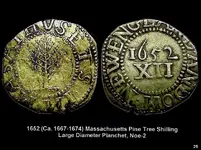you know... everything in those days had some sorta hidden reason/meaning...
Like I said... maybe a sign of "down with the tree" significance.
It was purposely put on side when I look at it... was not random.
Which in my opinion makes it even more unique/rare.
Not to be argumentative, but a few points come to mind in response to member posts:
- One of the chief reasons for making a hole in a coin was to hang it on a string or wire so that it could be hidden inside a coat or other clothing for security. That practice appears to have been much more common than wearing a coin as a pendant. These guys didn't have pockets as we know them today. In that case, the orientation of the hole wouldn't matter.
- Noe-1 is a "large planchet" variety that was likely struck on a roller or rocker press, as opposed to "small planchet" varieties, which were struck on a screw press. LP varieties have larger diameters that vary from coin to coin. There is no standard diameter. SP varieties such as Noe-29 do come closer to uniform diameter. Many LPs are not even round because they were trimmed to meet the weight standard, or because they are clipped by unscrupulous individuals. Both LP and SP varieties were made to a standard of 72 grains. With 15.43 grains to the gram, that's about 4.66 grams. Rarely does a full-planchet (unclipped) Mass shilling weigh less than 68 grains (4.41 grams). Most copies are heavy because they contain lead or other soft metal.
- It is actually very common for LP varieties to have edge splits (See attached. My Noe-2, also a LP variety. This one weighs 71.3 grains. Sorry about the pic quality. Also note that Noe-2 used a different die combination than Noe-1, so this one won't look like yours.) There isn't universal agreement as to why the splits, but I believe it has to do more with the preparation process than with striking. I have a couple of Noe-1 copies, bought at the Saugus (MA) Ironworks gift shop. Steel for making some of the mint equipment for the MA silver coins may have been made there. If I can find the copies, I'll post pics. National Geographic published a Historical Atlas of the United States a few years ago. On the cover are two pine tree shillings. Both are copies.

And, when you see a pine tree shilling copy, it's usually Noe-1.
- The edge-on photograph does look thick to me, and I'm pretty sure it has a seam. The SP pieces are thicker, but smaller diameter. You could easily bend a LP shilling in your fingers - though I wouldn't recommend it! The LP varieties sometimes exhibit an S-bend when viewed edge-on, a product of the manufacturing process and the general thinness of the stock.
- Chris Salmon and Louis Jordan have published excellent books on Mass silver and Lou provides excellent information on the Notre Dame website at
COLONIAL COINS (Table of Contents). Also see (bottom of webpage)
The Colonial Coin Collectors Club.
- Anyway, I hope that your coin is genuine, but, in my opinion, it is not. And you shouldn't be discouraged if it isn't. Nice find!
Best,
Born2Late

 And, when you see a pine tree shilling copy, it's usually Noe-1.
And, when you see a pine tree shilling copy, it's usually Noe-1.
